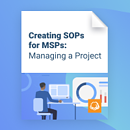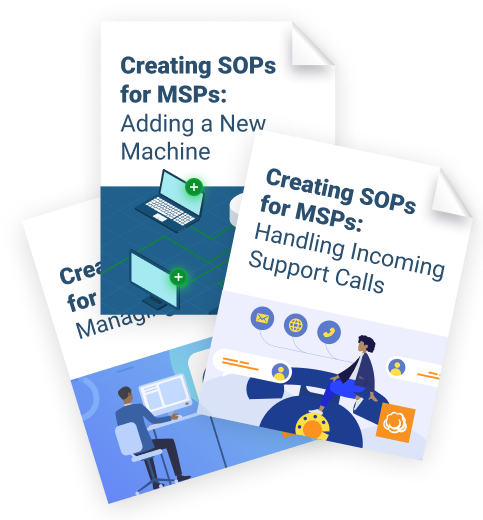IT project management has grown into a buzzword nowadays. However, you don't need sophisticated project management during routine operations, since it will make things unnecessarily complex. Nevertheless, there are certain cases when even small teams win from implementing the right IT project management frameworks. These include:
- Outlining a complex project, such as infrastructure updates, technology changes or a new office setup.
- When the company grows, which implies the development of internal applications, more complex infrastructure, and a greater overall reliance on IT operations.
If you want to be ready for such scenarios, you should consider IT project management best practices, which we overview in this article. So, let's dive in.
IT Project Management Basics
This concept encompasses the planning and implementation of an IT project. This process includes defining the strategy and operations, finding and allocating resources, accountability, implementation and, in the end, reporting and overview.
As we have already mentioned, you can apply IT project management fundamentals to any complex IT project, including cloud implementation, database and application development and management, hardware and solutions implementation, security audits, and enhancements.
IT Project Management Lifecycle and Frameworks
There are different methodologies that greatly affect the way you carry out the given task. These methodologies, the frameworks, can be categorized according to the way they are planned and executed.
There are two big groups of frameworks: linear, such as the waterfall technique, where all requirements, phases, and details are approved prior to the beginning of the project, and iterative, which includes agile-family frameworks that are hugely popular among developers, such as Scrum and Kanban. Here, each phase consists of the same processes and is intended to be accomplished with a specific result by the set deadline. These phases are repeated until the final goal is reached.
Further reading Agile MSP: The Concept Explained
IT Project Management Phases
Depending on the framework you choose for your project, there will be a huge difference in the planning and implementation processes. However, there are core components that are similar for all methodologies:
- Concept. First of all, you need to define the overall need, purpose and outcome of the project.
- Planning. When you've defined the need, you should start defining the details of the project, including budgeting, team, and other resources, timeframes, KPIs, and possible risks.
- Execution. If you have planned your project right, execution becomes a less daunting process. You should simply follow the milestones you've already set.
- Close. Once the project is over, you should overview the results and the issues you've encountered, and consider whether you could improve any processes for future projects.
Further reading Project Management for MSPs: What to Keep in Mind

IT Project Management Best Practices
No matter which framework you choose, it's the inherited experience that allows you to plan the project well and finish it in a satisfactory manner. Here are some best practices from experienced IT project managers:
1. Set realistic goals. First and foremost, you should be realistic regarding your goals, KPIs, and timeframes. If you realize that you cannot meet your expected targets, don't hesitate to change them.
Further reading Introduction to Financial KPIs
2. Failed projects are valuable. If you haven't met the goals of the project, you should focus on the post-mortem to establish ways of avoiding such results in the future.
3. Meet regularly and be open. When you are managing a project team, the first thing you should embed into your culture is openness. Hiccups and hurdles can happen, even if your team is skilled and well prepared for the project. So you should regularly discuss the ongoing situation and be open about everything problematic.
4. Review each phase. You should collect data on the KPIs, met and unmet goals, and other processes so as to be able to review them at each step. This will allow you to increase the quality of the subsequent steps and the next projects.
5. Keep an eye on resources. During the project implementation phase, it might turn out that your team lacks resources, such as applications or equipment. Collect requests during the project and pass them on for budgeting.
6. Use tools. There are dozens of tools purposely built for IT project management. If you are running your first projects, there's no need to invest in something feature-rich and hence expensive, like Jira or Asana. You might be better off with the easier and cheaper Trello (there's also a free version available).
IT Project Management for SMBs
We have already mentioned that, in some cases, IT project management fundamentals should be applied to projects in relatively small teams. Any significant infrastructural change is better to be well planned and executed. These are the reasons behind the need for IT project management implementation for SMBs:
- Benefits for the team. If done right, these frameworks enhance communication and cooperation between various teams. IT project management is oriented towards results, rather than routine operations, which greatly helps to achieve more in shorter periods of time. Moreover, the whole company will significantly benefit from streamlined and well-thought-through IT operations, since it's IT that supports all communications and most business processes in a modern company.
- Benefits for the clients. Quality and a customer-centric approach are the core principles behind any IT project management framework.

IT Project Management Bookshelf
IT project management is a complex area. So you need to carefully overview the most popular frameworks and approaches to make an educated choice. Here are some of the most popular books on the matter:
- Visualizing Project Management: Models and Frameworks for Mastering Complex Systems 3rd Edition
- Rapid Development: Taming Wild Software Schedules
- The Mythical Man-Month: Essays on Software Engineering (2nd Edition)
- Performance-Based Project Management
- Project Management with CompTIA Project+: On Track from Start to Finish, Fourth Edition 4th Edition
Conclusion
The implementation of IT project management frameworks can be a huge step for both your career and the efficiency of your business’s IT operations. Don’t forget that there are a number of frameworks out there and they each have their advantages and disadvantages, so take the time to evaluate each to find the most suitable for your workflow and projects.







